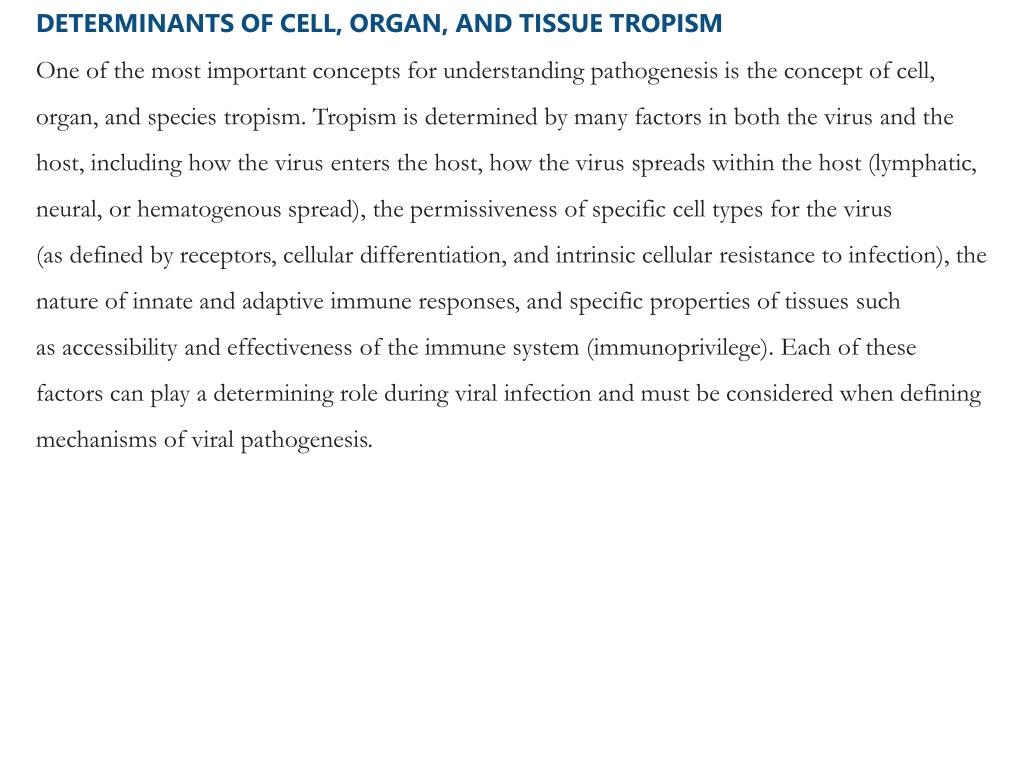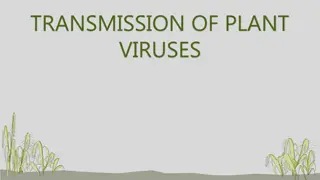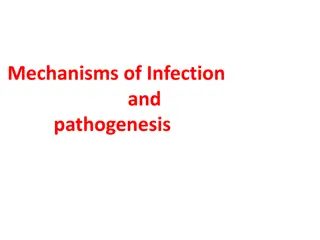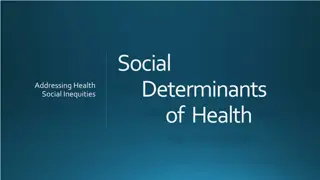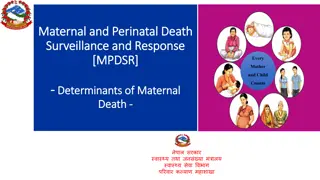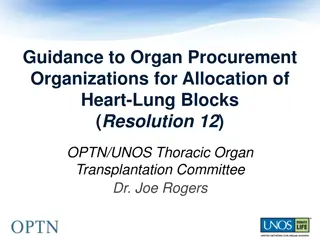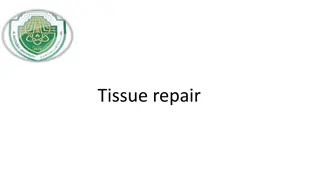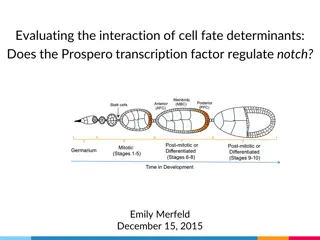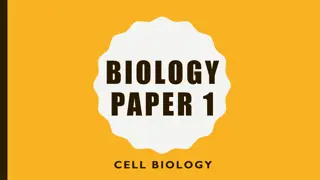Understanding Determinants of Cell, Organ, and Tissue Tropism in Viral Pathogenesis
Cell, organ, and tissue tropism are crucial in viral pathogenesis, influenced by factors such as routes of entry and spread within the host, cell permissiveness, and immune responses. Viruses penetrate epithelial barriers through various mechanisms to establish infection, navigating specialized cells and overcoming immune barriers. This complex interplay determines the course of viral infections and highlights the importance of considering multiple factors in understanding viral pathogenesis.
Uploaded on Sep 26, 2024 | 0 Views
Download Presentation

Please find below an Image/Link to download the presentation.
The content on the website is provided AS IS for your information and personal use only. It may not be sold, licensed, or shared on other websites without obtaining consent from the author. Download presentation by click this link. If you encounter any issues during the download, it is possible that the publisher has removed the file from their server.
E N D
Presentation Transcript
DETERMINANTSOFCELL,ORGAN, ANDTISSUETROPISM Oneofthemostimportantconceptsforunderstandingpathogenesisistheconceptofcell, organ,andspeciestropism.Tropismisdeterminedbymanyfactorsinboththevirusandthe host,includinghowthevirusentersthehost,howthevirus spreadswithinthehost(lymphatic, neural,orhematogenous spread),thepermissivenessofspecificcelltypesforthevirus (asdefinedbyreceptors,cellulardifferentiation,andintrinsic cellularresistancetoinfection),the natureofinnateandadaptiveimmuneresponses,andspecificpropertiesoftissuessuch asaccessibilityandeffectivenessoftheimmunesystem(immunoprivilege).Eachofthese factorscanplayadeterminingrole duringviralinfectionandmustbeconsideredwhendefining mechanismsofviralpathogenesis.
EntryintotheHost Avirusmustaccesspermissivecellstoestablishinfection andthereforemustovercomea seriesofanatomicandinnate immunebarrierstoenterthehost.Therouteofentryandthe mechanismsofspreadarethereforeimportantdeterminants ofviraltropism.Therouteand tissuethroughwhichavirus infectsthehostmaybeclearfromepidemiologicstudies.For example,bothmeaslesvirusand VZVspreadbytherespiratory route,andpoliovirusesand norovirusesspreadfecal orally. However,evenwhentherouteofinfectionisknown,thepreciseeventsinvolvedinentryintothe hostaremostlyunknown. Therearesixprimaryportalsofentryforviruses,each usedbyavarietyofviruses.Fiveof theseareepithelialsurfaces: skin,conjunctiva,respiratorytract,gastrointestinaltract,and genitourinarytract.Thesixthistheuniqueinterfacebetween themotherandthegermcellorthe developingfetus.
PenetrationThroughEpithelialBarriers Thebodyiscoveredbyepithelia,presentingalargesurfacefor virusestoaccess.However, epitheliashareseveralproperties thatinhibitviralentry.Forexample,epithelialcellsare constantlyturningoverandbeingreplenished;thus,cellsthatare contactedbyavirusareshed continuously.Theskinhasan addedprotectivemechanism,beingmanycellsdeepwiththe surfacecomprisedofmetabolicallyinactivecellsthatcannot supportviralreplication.In addition,barriersmaybeprotectedbylowpHorsecretions,includingmucus. Epithelialtissuesarehighlyactiveimmuneorgans.Inall epithelia,DCs(e.g.,Langerhanscells intheskin)serveassentinelsforinvasion,havingthecapacityto,whenactivated,move tolymphnodestoinduceimmuneresponses.Thesesentinel cellsplayadualroleininfection, bothascriticalforinduction ofimmunityandascellstargetedbyvirusesasaninitialsiteof infection.Forexample,whenVEEisinoculatedintomice,the firstcellsinfectedareDCs;these cellsrapidlymovetodraining lymphnodes,providingthevirusaccesstothelymphaticsys- tembutpotentiallyatthecostoftheinductionofimmunity(Fig.10.6).DCsliebeneaththe intestinalcolumnarepithelium,andthustheintestine,aswithskin,hasaresidentDC populationplausiblyinvolvedinsentinelfunctions.
Virusescrossepithelialbarriersthroughmechanical breaches(e.g.,vectorbornedeliveryofarbovirusesorbite wounddeliveryofrabies)orbyaccessingspecializedcells
withintheepithelium.Anexcellentexampleofthislattersituationisprovidedbyreovirus,withintheepithelium.Anexcellentexampleofthislattersituationisprovidedbyreovirus, whichaccessesthePeyer spatch throughspecializedepithelialcellscalledMcells.Upon entryintotheintestine,thereovirusvirionisproteolyzed,triggeringaremarkable structuraltransitionwithcleavageandloss Manyvirusesinfecteithertheimmaturefetusorthenewborn duringthebirth aprocess referredtoasverticaltransmission. Therearetwomechanismsforentryintothedevelopingfetus. The firstisviaplacental penetration,aswhenavirusentersthe fetusafterinvasionofthefetalcirculationor amniotic fluid. VirusessuchasHCMVandrubellacanspreadtransplacentally,withdevastating consequencesforthedeveloping fetus. Viruses such as human endogenous retroviruses (HERVs) canalsobeverticallytransmittedviathegermlineandconstituteasignificant fractionofthehumangenome.HERVs continuetoproliferatewithinthegenomeand arelikelyto exertbothbeneficialanddetrimentaleffectsontheirhosts.
SystemicSpreadofVirusInfection Virusesspreadviathreehostsystemsthatcanprovide accesstoalargenumberoftissues andcells:blood,lymphatics,andnerves.Althoughthebloodisamajorhighwayfor spreadofvirusesthroughthehost,manyvirusesusenervesor acombinationof hematogenousandneuralspreadtoaccess hosttissues. Thelevelofviremiahasbeencorrelatedwiththeseverity ofacuteviraldisease,the prognosisofchronicviraldisease(as inHIV),theextentofviraldissemination,andthe efficiencyof viralspreadbetweenhosts.Thelevelofviremiaisafunctionofviralaccessto theblood,viralclearancefromtheblood, andthevehicle(plasmavs.cellassociated)thatthe virususes totravelthroughtheblood.
Theclassicalexampleofthisstrategyisrabiesvirus,whichspreadsalongnervesfromtheareaTheclassicalexampleofthisstrategyisrabiesvirus,whichspreadsalongnervesfromthearea ofinoculationtotheCNS.Thetimebetweeninoculation anddevelopmentofsignsand symptomsofrabiesencephalitisdependsonthelengthofthenervesbetweenthesiteof inoculationandtheCNS.Thevirustravelsupnervestoward theCNSatarateof50to100 mm/day,andthediseasecan becuredbysurgicalremovaloftheinfectedlimbaslongas thevirushasnotenteredtheCNS.Forexample,ifthe initialbiteisonalowerextremity,there isalongertimewithin whichvaccinationandpassivetransferofrabies-immuneantibodycanbe effectivethanifthebiteisontheface. Importantly,theimmunesystemcanalsomodulateneuralspread.Forexample,antibodiescan interruptmanyofthe stepsinneuralspreadofreovirusestoandwithintheCNS.
TheRoleofViralReceptorsinCell, Tissue,andSpeciesTropism Animportantstepinviralinfection,andaprimarydeterminantofthedistributionofvirus betweenandwithintissues,is theinteractionofaviruswithspecificreceptorsonpermissive cells.Receptorexpressionplaysamajorroleindetermining thetropismofseveralviruses, includingpoliovirusandmeasles virus, and the use of molecular tools, including transgenic mice, expressingthevirus-specificreceptorsprovideskeyinsights intotheroleofreceptors inregulatingviraltissuetropismand pathogenesis.
InnateImmunityandIntrinsicCellular ResistancetoInfectionDetermineTropism Factorsinadditiontospecificreceptorsplayamajorrolein determiningviraltropism.Tropism canbedeterminedbyproteins responsible for cell-intrinsic defense against viral infection, transcriptionfactors,cellcycleregulators,andmicroRNAs.For example,theliver-specifichost microRNAmiR-122isessentialforrobustHCVreplication,137andinhibitionofmiR-122 innonhumanprimateslimitsHCVreplication. Onceavirushasboundtoacellanddelivereditsgenome orcapsidtothecytoplasm,aseries ofeventsoccurthatcan haveaprofoundeffectontheviralcelltropism.Theseevents likelyexplainwhyreceptorexpressiondoesnotalwaysexplain thecellandtissuetropismofa virus. Thehostcellexpresseson itscellsurfaceandinitscytoplasmmoleculesthatcaneither directlyinhibitviralreplication(intrinsiccellularresistanceto infection)orcaninduceasignaling cascadethatinturngeneratesantiviralmolecules(innateimmuneresponses).Together, these moleculesandpathwaysaredeterminantsofboththe permissivenessofcellsforviral replicationandspeciestropism.
Immunoprivilege .Forexample,instudiesofLCMVinfectionofmice,32,38manyorgansincludingliver,spleen, lung, andpancreasareclearedrelativelyefficientlywithin30daysof transferofimmunecells. However,viruspersistsintheCNS forupto90daysandinthekidneyandgenitourinarysystem formorethan200days,indicatingthatboththeCNSand thegenitourinarytractare immunoprivileged.Thesedataalso showthatimmunoprivilegeisarelativeterm,withtheefficacy oftheimmunesystemvaryingdependingonwheninfection isanalyzed.Analysisofthemiceata timepointmorethan 90daysaftertransferofimmunecellsidentifiesonlythegenitourinarytract asimmunoprivileged(Fig.10.9). Itislikelythattheselectiveinabilityoftheimmunesystemto clearvirusinfectionfromcertaintissuesisowingtoa combinationoftwointerrelatedfactors. Thefirstisintrinsic limitationsofimmunesystemfunctionincertaintissuesor tolimited capacitytoaddressinfectionofcertaincelltypes. Forexample,CD8Tcellsmaybemore effectiveateliminatinginfectionfrommajorhistocompatibilitycomplex(MHC) classI expressinghepatocytesthanfromneuronsthatdonot expressMHCclassImolecules.The secondfactorisviralevasionofimmunity.AnexampleofthisisthecapacityofHSV toevade clearancebythehostimmunesystemviaestablishmentoflatencyinneurons.
CellularDifferentiationasaDeterminant ofViralTropismandPathogenesis Anotherimportantdeterminantofviraltissuedistributionis cellulardifferentiation.Thus,cells atdifferentstagesofdifferentiationmayhavespecificpropertiesthatfavorordisfavor viralinfectionorreplication.Thisisespeciallytrueinatissue respondingtovirus-induced damage.Forexample,whenhepatocytesaredamagedduringchronicHBVorHCVinfection, theliverregenerates,providingviruseswithaccesstocellsin differentdifferentiationstates. Manyvirusestakeadvantageofdifferentiatedfunctionsof thecellsthattheytarget.For example,HSVestablisheslatency infullydifferentiatedneurons,andEBVlatentlyinfects memoryBcells;ineachcase,thereservoirforchronicinfectionisa particularlylong-livedcell type. Papillomavirusinfectionoftheskinprovidesanoutstandingexampleoftheimpactofcellular differentiationonpathogenesis(Fig.10.10).Innormalskin,basalstemcellsgive risetoevermoredifferentiatedcellsthatmovetowardtheskin surface,losetheirnucleus, becomecornfield,andare finally shed.
Papillomavirusesinfectbasalstemcellsoftheskin,where theycanpersistinalatentstatefor prolongedperiods.Activationofaprogramofgeneexpressioninitiallyinvolvingthe expressionofE6andE7proteinsresultsincellcycleprogression,inhibitionofapoptosis,and viralreplication.Asinfected cellsdifferentiateandmovetowardtheskinsurface,they becomepermissiveforexpressionofgenesinvolvedinviral replicationandassembly. Thenormaldifferentiationprocessissubvertedbythevirus,resultinginretention ofthenucleusandsynthesisofproteinsrequiredforviralDNA andproteinsynthesis. The virusassemblesandisreleasedfrom theskininshedcells. Theprinciplethatcellulardifferentiationisadeterminantofviralpathogenesisisvery importantandgeneral.When tissuesaredamaged,stemcellsareactivatedtogeneratenew cellswithconsequentproliferationofsomaticcellsanddifferentiationintocellssuchas hepatocytes,endothelialcells orepithelialcells.Theseprocessesareplausiblysubvertedby severalviruses,manyofwhichgrowoptimallyinreplicating cells.
FATEOFTHEINFECTEDCELL, TISSUE,ANDHOST The presence of avirus in atissue may or may not result in damage. Thevariablesthatdetermine thefateoftheinfectedtissue andhostarecomplexandinvolvetheinterplaybetweenthe virusanditscytopathicpotential;theage,sex,andnutritional statusofthehost;theregenerative capacitiesofdifferentprimarycelltypes;whethertheimmunesystemdamagesthetissueaspart oftheprotectiveresponse;whetherthevirusinduces autoimmuneresponses;andperhaps mostimportantly, whetherthevirusiseverclearedfromthetissueand,ifnot, thenatureof residualvirusinfection.Determinantsoftissue damagemaybelocalinnature,suchasthedeath ofinfected cellsowingtoviralcytopathicityorkillingbyimmunecells, oroperativeoverlonger distances,asinthecaseofvascular damageleadingtoischemia,systemichormonalandcytokine responses,inductionoffeverorcachexia,cytokineinduction ofthedeathofuninfectedcells, metastatictumors,orvirus-inducedautoimmunity. AgeasaDeterminantofSusceptibility toViralInfection Manyviralinfectionsarefarmoresevereinyoungthanolder hosts anincreaseinseveritythat oftencorrelateswith increasedreplicationanddisseminationofvirus.Forexample,suckling micehavelongbeenusedtoisolatenewviruses becausetheyhavegreatersusceptibilitytovirus infectionthan maturemice
Thisobservation extendstomanyotherviruses,includingpoliovirus,where 2-week-old poliovirusreceptortransgenicmiceare10,000 foldmoresusceptibletoparalyticdiseasethan adultmice. .Itiscommonlyconsidered thatmaturationoftheimmunesystemexplainsincreasedresistance toinfectionsseeninolderhosts.However,thishasnot beenrigorouslydemonstratedasthereason forage-dependent susceptibilitytoviralinfection.Otherage-dependentprocesses, suchascellular differentiationandproliferation,mayplayarole aslargeasthatoftheimmunesysteminage- relatedsusceptibility.Forexample,thegenesexpressedinthenervoussystem duringinfectionof youngerversusolderhostsdiffer,indicatingthattherearefundamentaldifferencesinhowolder and youngertissuesrespondtoviralinfection.
FateofInfectedandUninfectedCellsinTissues Theconsequencesofviralinfectionrangefrom rapiddestructionoftissuecells,asseenwith variolaorEbola viruses,tocontinuousreplicationintheabsenceofsevere cytopathology, asseenwithLCMV,totheestablishmentof latency,asseenwithherpesviruses.
DirectKillingofCellsbyViruses Cytopathiceffectisdefinedasthedestructiveconsequencesof virusinfectiononcells.Direct killingofcellsbyvirusesmaybe attributabletoviralsubversionofcellmetabolismfor replicationortocell-intrinsicprogrammedcelldeathpathwayssuch asnecrosis,apoptosis,or nonnecroticandnon apoptoticcell death. Thetermcytopathiceffectismostcommonlyusedto describetheconsequencesofinfection inculturedcells.Cell deaththatoccursinaculturedcellmayormaynotreflect the processofcelldeaththatoccursinvivo.Anadvantageof studyingcelldeathandcytopathicityin culturedcellsisthat theinteractionbetweenthevirusandthecelloccurswithout cell-extrinsic factors,withexceptionofthoseowingtoautocrinestimulation(e.g.,theexpressionof interferonsbyinfected cells).Adisadvantageofthisapproachtostudyingcelldeathis that eventsinculturedcellsmayhavelittlerelationshiptowhat happensinprimarycellsinan infectedtissue.
.Itisimportant torememberthatthepresenceofinflammationdoesnot necessarilyindicatetheparticipationofinflammatorycells inthekillingofinfectedcells. Inflammatorycellsmaybe beneficialorpresentasahostresponsetokilledcells and tissuedamageratherthanbeingparticipantsinthedeathof infectedcells.
KillingofCellsbyCell-Extrinsic EffectsoftheImmuneSystem Notallcelldeathinaninfectedtissueisaresultofdirectviral effectsorcell-intrinsic mechanismsofprogrammedcelldeath triggeredbythepresenceofthevirus.Thehost hasmany cell-extrinsicmechanismsforinitiatingapoptosisorlysisof infectedcellsvia cytokines,serumproteinssuchascomplement,andproteinssuchasthegranzymesthatare injected viaperforinintoinfectedcellsbyleukocytes. Theroleofcellkillingbythelyticactivityofgranzymes isimportantbecauseperforin- and/orgranzyme-deficient micearesusceptibletocoronaviruses,WestNilevirus,LCMV, ectromeliavirus,HSV,Theiler svirus,MCMV,andmurine gHV. Thecomplementcascadeisatwo-edgedswordimportantforantiviralimmunitybut canalsocontributetovirus-inducedtissuedamage. Complementproteinsareinvolved ininductionofantibodyand T-cellresponses,trappingofviral antigenonantigen-presenting cells,inductionofchemotactic andvascularpermeabilitychangesininfectedtissues,and activationofleukocytes.Inadditiontobeingimmunoregulatory, complementcanlyseboth virus-infectedcellsandlyseorneutralizevirions.
ClearanceofVirusInfectionand ChronicViralInfection Afundamentallyimportantvariableinviralpathogenesisis whethertheimmunesystemcanclear avirusfromthebody. Somevirusesarereadilyclearedbutcandosignificantdamage tothehost duringtheirbrieftimeofresidenceinthebody.An exampleisvariolavirus,whichcauses smallpox.Thispattern ofacuteinfection(seeFigs.10.1and10.3)isassociatedwith developmentofsterilizingimmunityandeffectiveresistance toreinfection.Manyvirusesfor whicheffectivevaccinesare availablefallintothiscategory.Othervirusesarelessamenableto eliminationbytheimmunesystem,resultinginlatent, chronic,orprogressiveinfection(seeFig. 10.1).Examples ofchronicviralinfectionsofgreatmedicalsignificanceare thosecausedby HIV,HCV,andHBV.Otherchronicinfectionsarelessconsistentlyharmfultotheirhostsbutdo cause significantdisease.Examplesincludeherpesvirusessuchas EBV,VZV,HCMV,and HSV,eachofwhichpermanently infectsmosthumanbeings.Itispossiblethatsuchchronic infectioncan,inadditiontocausingdiseaseinrarecases,provideasymbioticbenefittothehost viachronicstimulationof theinnateimmunesystem,includingmacrophagesandNK cells.
TissueDamageDuringBeneficialImmune ResponsesIsaNecessaryEvil Althoughthereareclearexamplesinwhichtheimmune systemisprimarilyresponsiblefor virus-inducedtissuepathology,andthusdiseaseisimmunopathologic,thesituationisseldom thatsimple. Theantiviralimmuneresponsehastwofaces: abeneficialfaceasthehostsystemresponsibleforcuringinfectionandaharmfulfacevia inductionoftissuepathologyand systemictoxicity. Thissetsthestageforconsiderationof oneof themostcomplextopicsinviralpathogenesis:therelationship betweenimmune- mediateddamageandclearanceofinfection. Itisnotalwaystruethatthefunctionoftheimmunesystemcausespathology.Forexample, protectiveeffectsofantibodythatdonotdamagetissuesareseeninmostifnotallviral infections.
ImmunopathologyOccursWhen theImmuneSystemGoesTooFar Insomecases,thebalancebetweentheprotectiveeffectsof immunityandtheharmfuleffectsof immunityclearlyshifts toimmunitybeingtheprimarycauseoftissuepathologyand evendeathofthehost.Theseprocessescanbedrivenby overactiveinnateimmuneresponses, whichresultininflammatoryresponsesthatdrivevirus-inducedtissuepathologyand disease, nonspecificcellkilling,oreveninductionofautoimmunitybythehostadaptiveimmuneresponse. Thebalance betweenacceptabletissuedamageassociatedwithviralclearanceand immunopathologyisdeterminedbytheeffectiveness oftheimmunesysteminclearingthe infection.Forexample, evenseverehepatitiswouldbeanacceptableoutcomeofHCV infectioniftheviruscouldbecleared;however,theimmune responsetoHCVinfectionis oftenineffective.Immunopathologycanbeattributabletoeither T-orB-cellresponsesorto innateimmunityandmaybetheconsequenceofvirus-induced immuneresponsestoeitherviral antigensor,inthecaseof inducedautoimmunity,hostantigens.
Virus-InducedAutoimmunity Avariantmechanismofimmunopathologyistheinduction ofautoimmunitybyvirusinfection. Thecontributionsofautoimmunitytotissuepathologyassociatedwith viralinfection,orputativelyassociatedwithviralvaccination, remainquitecontroversial.The roleofautoimmunityinvirus infectionandpost infectionsyndromeshasbeenstudiedin severalsystems,andviruseshaveatonetimeoranotherbeen candidateetiologicagentsfor manyautoimmuneorinflammatorydiseasesinhumans,includingrheumatoidarthritis,multiple sclerosis,Crohn sdisease,myocarditis,uveitis,hepatitis, Sj gren ssyndrome,andtype1diabetes. Aproposedmechanismfortheinductionofautoimmunityismolecularmimicrybetween virusandhostantigensleadingtoabreakdownofself-tolerance.Thismight plausiblyoccurin thesettingofvirus-inducedtissuedamage andinflammation.
VIRALDETERMINANTSOFVIRULENCE MutationandSelectionofViralVariants Anexcellentexampleofamutationcontributingtothe pathogenesisofviralinfectionis theemergenceofimmune escapemutants.Theprinciplethatviralescapemutantscan evadeCD8responseswas firstidentifiedbystudyofmurine LCMVinfection.227Inthisstudy, investigatorscreatedT-cell receptortransgenic(LCMVTCRtg)micecontainingalarge numberofTcellsspecificfortheepitopecontainingamino acids32-42oftheLCMV glycoprotein.Within8daysof infection,manyLCMVisolateswerenolongerrecognized by TCRtg T cells and contained mutations in the 32-42epitope.227 Importantly,mutationsinotherT-cellepitopesthatwerenot recognizedbyTCRtgTcells werenotselected,indicatingspecificityoftheselectivepressure.
Virus-InducedImmunosuppression Virusinfectionisoftenassociatedwiththeinductionofan immunosuppressedstate. Immunosuppressionisdefinedas avirusinfection-associateddecreaseinthecapacityof the immunesystemtorespondtoantigen.Thephenomenonof immunosuppressionwas first notedasinhibitionoftuberculinskintestreactivityduringmeaslesvirusinfection. Thatinitialobservationhasbeenfollowedbyadelugeof reportsofalteredimmune reactivityinvirus-infectedhosts.
Animmunosuppressedstatemaybenefitavirusbyinhibitingantiviralresponses;however,itisAnimmunosuppressedstatemaybenefitavirusbyinhibitingantiviralresponses;however,itis importanttodistinguish betweenimmunosuppressionandviralimmuneevasionthat occurswithoutinducingageneraldeficiencyinimmunefunction.Itisalsoimportantnotto confuseimmunosuppression withthenormaldown-regulationofvirus-specificresponsesthat occursasviralinfectioniscleared.Therearethreecategoriesof immunosuppressive mechanisms.In the first, virus kills significant numbers of critical immune system cells; an example of this is HIV-associated depletion of CD4 T cells. Likewise, LCMV clone 13causes immunodeficiencyowingtodestructionofDCsthat arecriticalantigen-presentingcells.Inthis case,activatedCD8T cells that recognize viral antigens expressed by infected DCs damagethe immunesystem.Asecondpotentialmechanism involvesalterationsincytokinesecretionby infectedcellsorthe inductionofsecretedmoleculesthatinhibitimmuneresponses. Thismechanism,however,doesnotprovideaclearexplanationforacaseinwhich immunosuppressionpersistslongafter infectionisthoughttobecleared.Athirdbutlargely speculative potentialmechanismonlynowbeingexploredisviralinduction ofregulatory Tcells thatmayinhibittheimmuneresponse.
ViralEvasionandSubversionof HostCytokineResponses Hostmoleculespresentintheextracellular fluidincluding cytokines,prostaglandins, steroidhormones,peptidehormones, growth factors, and serum components such as complement provide important targets for viral evasion and subversion strategies.Viruses encodemoleculesthatevadeorsubverthost hormonalandcytokineresponsesthatregulate bothinnateand adaptiveimmunity,suchasinterferons, TNF,IL18,IL6,IL10, complement,and chemokines
